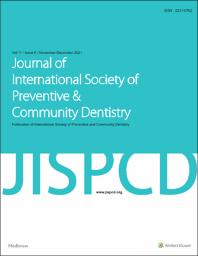Mostrar el registro sencillo del ítem
Evaluation of Buccal Bone Wall Thickness of Anterosuperior Teeth and Nasopalatine Duct Morphology in Cone Beam Computed Tomography of Patients Living at Different Altitudes: A Two-Year Retrospective Study
| dc.contributor.advisor | Alvarez, Jenny | |
| dc.contributor.author | Córdova-Limaylla1, Nancy E. | |
| dc.contributor.author | Rosas-Díaz1, José C. | |
| dc.contributor.author | Alvarez-Medina1, Rocío | |
| dc.contributor.author | Palomino-Zorrilla1, Jerson J. | |
| dc.contributor.author | Guerrero-Acevedo2, Maria E. | |
| dc.contributor.author | Cervantes-Ganoza3, Luis A. | |
| dc.contributor.author | López-Gurreonero4, Carlos | |
| dc.contributor.author | Cayo-Rojas1, César F. | |
| dc.date.accessioned | 2021-12-16T19:14:34Z | |
| dc.date.available | 2021-12-16T19:14:34Z | |
| dc.date.issued | 2021-10-28 | |
| dc.identifier.uri | https://hdl.handle.net/20.500.14308/3442 | |
| dc.description.abstract | Aim: To evaluate the buccal bone wall thickness of anterosuperior teeth and the dimension and morphology of the nasopalatine duct in cone beam computed tomography (CBCT) of patients treated in two cities at different altitudes. Materials and Methods: In this retrospective analytical study, 79 CBCT scans were selected from a total of 347 in Juliaca, Peru (3824 m a.s.l.) and 171 CBCT scans were selected from a total of 622 in Lima, Peru (154 m a.s.l.). The buccal bone wall thickness of anterosuperior teeth was measured at 1mm, 3mm, and 5mm from the alveolar crest. For the nasopalatine duct, its length and diameter were measured, and its anatomical shape was determined in coronal view. Descriptive statistical data such as mean and standard deviation were used, and Mann–Whitney U test was used for bivariate analysis. Results: When comparing the CBCT scans from both cities, significant differences were observed in buccal bone wall thickness at 3mm and 5mm from the alveolar crest (P < 0.01 and P < 0.01, respectively); for men, at 1mm and 3mm (P = 0.04 and P = 0.04); for the age group from 33 to 47 years, at 3mm and 5mm (P < 0.01 and P < 0.01); and for the age group from 48 to 77 years, at 1mm (P = 0.02). Regarding the nasopalatine duct, significant differences were observed in women in relation to length and nasal opening diameter (P < 0.01 and P < 0.01) and for men, in length (P < 0.01); for the age group from 18 to 32 years, in all three levels (P < 0.01); for the age group from 33 to 47 years, in length and diameter of the oral opening (P < 0.01 and P < 0.01); and for the age group from 48 to 77 years, in length and diameter of the nasal opening (P < 0.01 and P < 0.01). The most frequent nasopalatine duct shape was a single canal with more than 66% of cases, according to sex and age group. Conclusion: Patients living at different altitudes presented significant differences in buccal bone wall thickness according to sex and age; however, there were no differences related to dental inclination. Significant differences were found in the length and diameter of the nasopalatine duct at the nasal opening. In addition, the most frequent shape of the nasopalatine duct was the simple canal. Keywords: Altitude, alveolar crest, bone wall, cone beam computed tomography, maxilla, nasopalatine duct | es_PE |
| dc.format | application/pdf | es_PE |
| dc.language.iso | en | es_PE |
| dc.publisher | Journal of International Society of Preventive and Community Dentistry | es_PE |
| dc.rights | info:eu-repo/semantics/openAccess | es_PE |
| dc.rights | Attribution-NonCommercial-NoDerivs 3.0 United States | * |
| dc.rights.uri | licenses/by-nc-nd/3.0/us/ | es_PE |
| dc.rights.uri | http://creativecommons.org/licenses/by-nc-nd/3.0/us/ | * |
| dc.source | Universidad Privada San Juan Bautista | es_PE |
| dc.source | Repositorio Institucional UPSJB | es_PE |
| dc.subject | Altitude, | es_PE |
| dc.subject | alveolar crest, | es_PE |
| dc.subject | bone wall, | es_PE |
| dc.subject | cone beam computed tomography, | es_PE |
| dc.subject | maxilla, nasopalatine duct | es_PE |
| dc.title | Evaluation of Buccal Bone Wall Thickness of Anterosuperior Teeth and Nasopalatine Duct Morphology in Cone Beam Computed Tomography of Patients Living at Different Altitudes: A Two-Year Retrospective Study | es_PE |
| dc.type | info:eu-repo/semantics/article | es_PE |
| dc.subject.ocde | http://purl.org/pe-repo/ocde/ford#5.01.01 | es_PE |
| dc.publisher.country | Perú | es_PE |
| dc.date.embargoEnd | 2021-12-15 | |
| dc.type.version | info:eu-repo/semantics/publishedVersion | es_PE |


